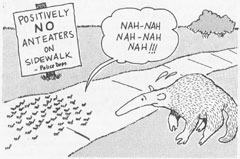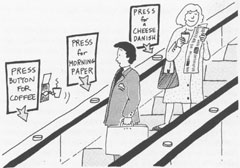Why do Clocks run clockwise? (7 page)
Read Why do Clocks run clockwise? Online
Authors: David Feldman

Executions in the United States were not always held in the wee hours. Until the 1830s, most executions were hangings, public 34 / DAVID FELDMAN
affairs that were usually performed at noontime in town squares.
Government and penal officials generally believed that public executions acted as a deterrent to would-be felons, so they timed them to attract the largest crowd possible.
Public executions were not without problems even for proponents of capital punishment. Condemned criminals were allowed to give a last statement, which often turned into a tirade against the government and the church. The public execution gave often deranged individuals an opportunity to mock the values and institutions that the justice system was designed to protect. Some criminals successfully played upon the sympathy of the crowd, portraying themselves as martyrs.
About this time, opposition to public executions began to be heard, with both philosophical and practical objections being raised.
Many found public executions barbaric, especially because the crowd more resembled crazed football fans than witnesses to a human death. Local merchants in big cities usually disliked public executions because they disrupted business (for the same reason, small-town merchants liked public executions—they attracted potential customers).
Sociologist Richard Moran of Mount Holyoke College, a leading expert on the history of capital punishment, stresses that throughout American history, those against it have sought public executions, believing that if the American public were exposed to the barbarity of executions, it would reject them.
Those in favor have always sought to make executions private.
This trend was first manifested in the 1830s, when several states decided to perform executions within prison walls. Rhode Island was the first state to abolish public executions, in 1833, and Pennsylvania followed the year after. Actually, the public could still attend hangings inside prison, but only by purchasing tickets. During this period, most executions were still held during the afternoon.
Slowly, many states began to move their execution times to late evening, midnight, and even predawn hours. The practice of execution at dawn dates back centuries, when the military of WHY DO CLOCKS RUN CLOCKWISE? / 35
many countries had firing squads execute the condemned as soon as there was enough light for the gunmen to see their target. Professor Moran, however, provides another reason for the early-morning hours: concealment. Even in the nineteenth century, most prison and government officials tried to diminish press coverage of executions, in order to minimize protest. Executions were held in the early morning so that the press couldn’t print stories about the execution in that morning’s newspaper. If they chose to cover the execution at all, the story had to appear on the following day, when it was likely to receive less prominence.
Some of the penal authorities we spoke to stressed the practical advantages of early-morning executions. Anthony P. Travisono, executive director of the American Correctional Association, told
Imponderables
that between midnight and six A.M., “there is very little activity at the institution and all is fairly quiet.” He added, rather eerily, “also, the surge of power is stronger.”
Professor Moran also suggests that prisoners are more disorderly on days of executions, so that performing executions while the in-mates sleep is prudent.
We asked Moran if early-morning executions could be an expression of collective, if unconscious, shame about the whole enterprise.
Although he didn’t take a definitive stand on the issue, Moran acknowledged the possibility and bolstered the contention with an interesting fact about electrocutions. Not only are today’s executions indoors and closed to the public, but electrocutions, without exception, are performed in rooms without windows. The grim task of taking a human life is accomplished without any natural light entering the chamber. We used to make executions a public ritual, sym-bolic of our repudiation of the criminal act and our affirmation of the need for justice. We now perform executions privately, almost furtively—as if we were the criminals.
36 / DAVID FELDMAN

Why Do Ants Tend to Congregate on Sidewalks?
With the help of several entomologists and pest control experts, we pieced together several reasons for this phenomenon.
1. Some species, particularly one actually called “pavement ants,”
prefer to nest on sidewalks and under rocks and other hard surfaces.
2. As John J. Suarez, technical manager of the National Pest Control Association, so elegantly put it: “Sidewalks are a favorite place for people to drop candy, fast food, food wrappers and soft drink containers.” Ants are known for their industriousness, but they aren’t dumb. If they are given offerings that require no effort on their part, they won’t decline the largess.
3. Ants release pheromones, a perfume trail left from the nest to food sources. Pheromones are easily detected on sidewalks, which, as we have already learned, are often repositories WHY DO CLOCKS RUN CLOCKWISE? / 37
for food. Ants on sidewalks, then, are often merely picking up the scent left by scouts before them.
4. Sidewalks absorb and store heat. Ants run around naked. They prefer warmth.
5. The most popular explanation: darkish ants are more easily visible in contrast to the white sidewalk than on grass or dirt. Suarez speculates that the greater warmth of sidewalks may make the ants more active as well as more visible. But don’t assume that because you can’t see ants on your front lawn they aren’t there. THEY ARE
EVERYWHERE.
Submitted by Daniel A. Placko, Jr., of Chicago, Illinois
.
Why Do American Cars Now Have Side-View
Mirrors on the Passenger Side with the Message,
“Objects in the Mirror Are Closer Than They
Appear”?
A reasonable person might ask why the American automobile industry had to “improve” on those hopelessly old-fashioned side-view mirrors that didn’t distort one’s perception of distance. And why, if the inside rear-view mirror shows objects without distortion, can’t the side mirror do the same?
Car manufacturers are required to provide flat, unit magnification mirrors on the driver’s side of the car. The driver-side mirrors offer the same undistorted image as the mirror in your medicine cabinet.
The new mirrors are convex (for those who forgot their high-school science, convex surfaces curve outward, as opposed to a spoon, which has a concave surface). Convex mirrors have one huge advantage over flat mirrors—they allow a much wider angle of vision. Engineers have found that convex side-view
38 / DAVID FELDMAN
mirrors afford drivers a much clearer view of the passenger side of the car than the old combination of rear-view mirror and conventional side-view mirror. The rear-view mirror, if used alone, leaves blind spots that can lull drivers into complacency when they are consider-ing making lane changes. Drivers are less likely to be sideswiped when consulting a wide-angle side-view mirror, even if an oncoming car is closer than it appears, because they are more likely to spot the car in the first place.
The immortal words, “Objects in the mirror are closer than they appear,” are mandated by federal law on all convex mirrors. The government has also set specific standards for the curvature of convex mirrors. The average radius of the curvature for convex mirrors should be no less than thirty-five inches and no greater than sixty-five inches.
Ed Stuart, a representative of Chrysler Motors, told
Imponderables
that the convex mirrors are particularly popular with freeway and turnpike drivers, who can see oncoming cars streaming in from entry ramps much more easily. The biggest danger of the convex mirror is that because objects in the mirror are closer than they appear, drivers will think they have more room to pass another car than they really do. But most drivers look through the undistorted rear-view mirror rather than the side-view mirror before making a lane change anyway, and the prudent driver should check over his shoulder before making his move.
Submitted by Loretta McDonough, of Richmond Heights, Missouri
.
WHY DO CLOCKS RUN CLOCKWISE? / 39
Why Do Dogs Smell Funny When They Get Wet?
Having once owned an old beaver coat that smelled like a men’s locker room when it got wet, we assumed that the answer to this Imponderable would have to do with fur. But all of the experts we spoke to agreed: the funny smell is more likely the result of dogs’
skin problems.
First of all, not all dogs do smell funny when they get wet. Shirlee Kalstone, who has written many books on the care and grooming of dogs, says that certain breeds are, let us say, outstanding for their contribution to body odor among canines. Cocker spaniels and ter-riers (especially Scotties) lead the field, largely because of their propensity for skin conditions. (Cockers, for example, are prone to seborrhea.) Jeffrey Reynolds, of the National Dog Groomers Association, adds that simple rashes and skin irritations are a common cause of canine body odor, and that water exacerbates the smell. In his experience, schnauzers are particularly susceptible to dermatolo-gical irritations.
Of course, dogs occasionally smell when they get wet because they have been rolling in something that smells foul. Gamy smells are usually caused by lawn fertilizer, for example.
Regular grooming and baths can usually solve the odor problem, according to Kalstone. Don’t blame the water, in other words—blame the owner.
Submitted by Robert J. Abrams, of Boston, Massachusetts
.
40 / DAVID FELDMAN
Why Do All Dentist Offices Smell the Same?
You are smelling what Dr. Kenneth H. Burrell, assistant secretary of the Council on Dental Therapeutics, calls the “mixture of essential oils dentists frequently use in the course of treatment.” Many of these oils are natural or synthetic derivatives of products found in your household. A number of dental medicaments contain camphor, the same pungent substance that repels moths, while others are derivatives of items found on the spice rack: thyme and clove.
The most prominent scent in the dentist’s office, the one that makes you claim that all dentist offices smell alike, is probably eu-genol, a colorless or pale liquid that is the essential chemical constituent of clove oil. Dentists combine solutions of clove oil or eu-genol with a mixture of rosin and zinc oxide to prepare a protective pack after gum surgery or as a temporary cement. Eugenol is also used as an antiseptic, especially in root-canal therapy, and as an anodyne (painkiller). This versatile liquid is also part of the mixture for temporary fillings, impression materials, and surgical dressings after periodontal work.
We at
Imponderables
have pondered of late why clove candies and gum have come and gone. Our pet theory is that rejection of this once-popular flavor comes from a generation of sense memories unconsciously associating cloves with the dentist’s office.
Submitted by Julie Lasher and Brian Scott Rossman, of Sherman
Oaks, California
.
WHY DO CLOCKS RUN CLOCKWISE? / 41

What Are Those Large Knobs Between Sets of
Escalators in Department Stores?
The knobs’ sole purpose in life is to keep miscreants from sliding down the flat space between the escalators—or at least to guarantee that if misceants
do
slide down in between the escalators, they’ll have a bumpy ride.
At Westinghouse Electric Corporation, the knobs are known as an “Anti-Slide Device” and are used on the wide decking between escalators or between an escalator and a wall. As Westinghouse engineer Robert L. Meckley points out, the knobs not only prevent rowdy kids from sliding down, but also keep purses and other bag-gage (such as Baccarat crystal) from flying down and crashing on the floor. Although the Anti-Slide Devices are hardly high-tech, they do the job.
Submitted by Liz Sblendorio, of Hoboken, New Jersey
.
42 / DAVID FELDMAN
Why Is Jack the Nickname for John?
Believe it or not, a whole book has been written on this subject:
The
Pedigree of Jack and of Various Allied Names
by E. W. B. Nicholson.
